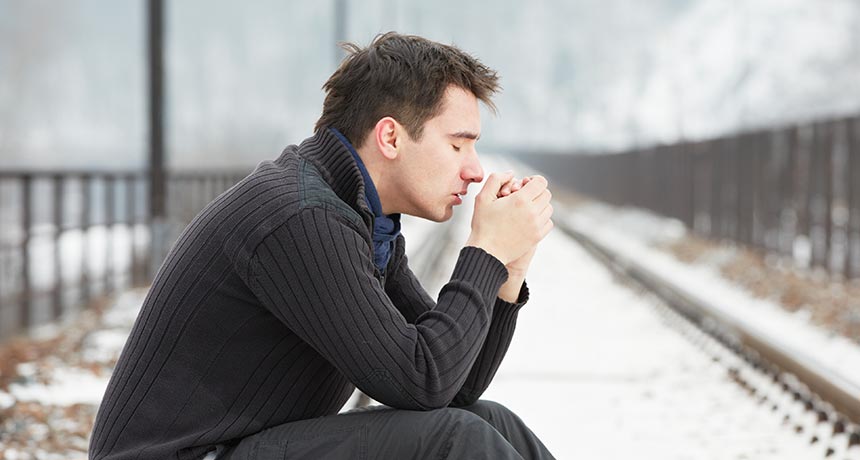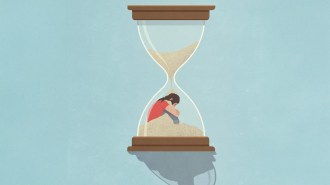Don’t blame winter for that bleak mood
Incidence and severity of major depression not linked to changes in season

DARK DAYS A controversial new study concludes that major depression does not afflict more people during winter months.
Chalabala/iStockphoto
Winter doesn’t deserve its dour reputation as the season of depression, scientists say.
Rates of major depression, a psychiatric condition marked by intense sadness, hopelessness, insomnia and a general loss of interest or pleasure, don’t markedly change from one season to another among U.S. adults, says a team led by psychologist Steven LoBello of Auburn University at Montgomery in Alabama. Neither do symptoms intensify or become more numerous during winter among those already suffering from depression, the researchers report online January 19 in Clinical Psychological Science.
A small number of people with regular fall or winter depression may have gone undetected in the new study, which surveyed more than 30,000 U.S. adults. Still, it’s becoming harder to justify the current psychiatric diagnosis of major depression “with seasonal pattern,” LoBello and Auburn colleagues Megan Traffanstedt and Sheila Mehta conclude.
Because it’s a recurring disorder, depression can strike in two consecutive winters by chance, the researchers say. Depression in three or more consecutive winters could be due to personal and social factors unrelated to shorter days, they add.
“Being depressed during winter is not evidence that one is depressed because of winter,” LoBello says.
Several previous large-scale studies of children, teens and adults in Europe and parts of the United States have also found no tendency for depression rates to spike in winter or any other season. But depression relegated to winter months, and a related condition called seasonal affective disorder (SAD), are real, says psychologist Kelly Rohan of the University of Vermont in Burlington. SAD’s depression symptoms are typically less severe than those of nonseasonal depression, she says. Based on previous population surveys, she estimates that SAD affects between 1 and almost 3 percent of U.S. and Canadian adults.
Clinicians have tracked thousands of people who, in their view, develop SAD every year, typically between September and January, says psychologist Michael Terman of Columbia University. SAD symptoms emerge in distinctive stages not usually seen in other types of depression, adds psychologist Michael Young of the Illinois Institute of Technology in Chicago. Sharp increases in sleepiness and appetite, and a loss of energy, often occur weeks before mood plummets. These symptoms improve in early to mid-April.
SAD research, which began more than 30 years ago, spurred the inclusion of a seasonal pattern of major depression — but not SAD itself — in psychiatry’s diagnostic manual starting in 1987.
LoBello and colleagues view SAD investigations as flawed. Researchers have usually asked psychiatric patients to recall the timing of depression bouts over the last year or more, which can result in memory errors. And many SAD studies have relied on a questionnaire that omits several major depression symptoms, the researchers say.
LoBello’s team therefore studied major depression with seasonal pattern as defined by the diagnostic manual. The investigators analyzed data from 34,294 U.S. adults surveyed once by phone during 2006. Surveys included a questionnaire focused on a full range of major depression symptoms. Participants recalled how many days in the previous two weeks they had experienced those symptoms, a manageable memory task.
People surveyed during the winter reported no more depression than those surveyed in other seasons. Neither did those who responded on days with little sunlight, as determined by data collected by the U.S. Naval Observatory. Volunteers from different parts of the country reported comparable depression rates, whether they lived in northern states with relatively low levels of sunlight exposure or states in sunnier regions. And among 1,754 participants whose survey responses indicated that they were currently depressed, symptoms were not worse or more numerous for those responding in winter.
The light-exposure finding runs counter to previous research, from as early as 1997, among people living at a wider variety of latitudes in different parts of the world. These studies have found that major depression during winter months increases as people increasingly slept through sunrise, a sign that reduced exposure to natural light undermines mood, Terman says.
The new findings don’t imply that bright-light therapy and talk therapy designed for SAD can’t ease depression, LoBello says. “These therapies might work but not for the reasons people think,” he says. Among the possible reasons they might work: therapists’ skill at connecting with patients and patients’ positive expectations about treatment.
Terman disagrees. Research now shows that people suffering from both seasonal and nonseasonal depression improve far more with morning bright-light exposure than with a sham treatment, such as sitting in front of a negative ion generator, he says. Urban settings that deprive people of natural light cause biological rhythms to drift out of sync with sleep, stoking depression in biologically vulnerable individuals, he proposes. A portion of these light-sensitive people develop SAD, he suspects.







